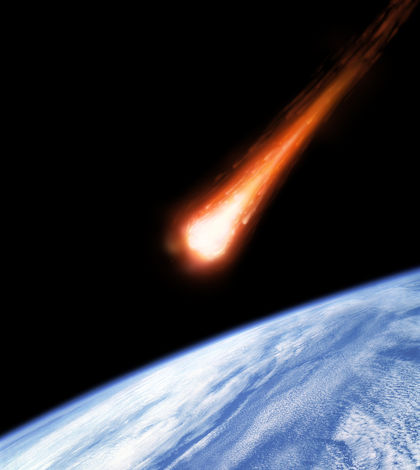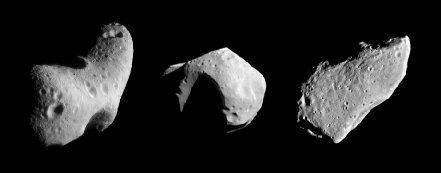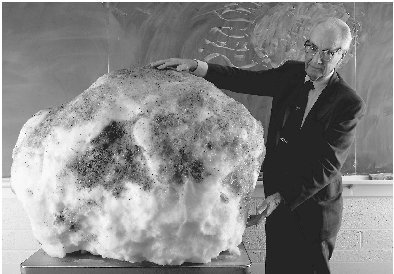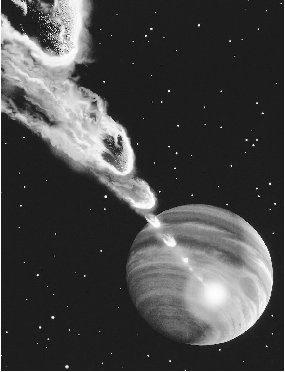Vital Statistics of Asteroids and Comets

"Imagine a package of rock and ice," David Levy challenges the reader, a small world lost in the depths of space far beyond Pluto. No larger than a village, this world, which we call a comet, moves lazily around the Sun. . . . Suddenly, something—maybe a passing star—causes it to shift. Instead of moving around the Sun, the ball of rock and ice now moves in a new orbit that takes it closer to the solar system's central star. 23
In this brief description of a comet floating in the distant Oort Cloud, Levy makes reference to the object's composition, its size, and its orbit, three of the four major vital statistics, so to speak, of comets. The other is the shape of such bodies.
Asteroids also possess vital statistics. Like comets, they can vary greatly in size, shape, and composition. And both kinds of cosmic bodies can move in a wide range of orbits, depending on such factors as where they formed, planetary and stellar gravitational attractions, and the force of random collisions. An added physical characteristic of asteroids is that some have satellites, or objects that orbit them, as many planets do. Clearly, the more scientists learn about asteroids and comets, the more varied and fascinating these objects seem.
Size and Shape
Perhaps the two most basic and visually obvious characteristics of asteroids are their size and shape. The largest known asteroid, as well as the first to be discovered—Ceres—is about 567 miles across, roughly the size of the state of Texas. This sounds very big. Indeed, all by itself Ceres contains about a quarter of the mass of all the known asteroids combined. On planetary scales, however, size can sometimes be deceiving. Approximately 4,000 bodies, each with Ceres' mass, would be needed to equal Earth's mass; and 318 Earth masses would be required to equal Jupiter's mass. So, the largest planet in the solar system is 318,000 times more massive than all of the asteroids put together.
Still, at least by human standards, Ceres and a number of other asteroids are very large bodies. In fact, twenty-six asteroids are more than 124 miles across, or bigger than the states of Massachusetts, Connecticut, and Rhode Island combined. The second-largest asteroid, Pallas, for example, is roughly 324

Astronomers have been observing the asteroid belt for so long that they believe they have found all of the large bodies inhabiting that region. In fact, nearly all of the asteroids in the belt that are bigger than sixty-two miles across have been discovered and inventoried. That does not rule out the possibility of finding more large asteroids in the future in either the Kuiper Belt or Oort Cloud. And of course, millions of smaller asteroids floating in the asteroid belt or elsewhere have not yet been discovered and cataloged.
Why Comets Have Odd Shapes
In this excerpt from their popular book on comets, Carl Sagan and Ann Druyan explain why small comets are not spherical.
Because the typical comet is so small, its gravitational pull is tiny. If you were standing on the surface of a cometary nucleus, you would weigh about as much as a lima bean does on Earth. You could readily leap tens of kilometers into the sky, and easily throw a snowball [into space]. . . . The Earth and the other planets tend to be almost perfect spheres because . . . gravity is a central force—it pulls everything equally toward the center of the world. . . . The mountains sticking up above the spherical surface of the Earth represent less of a deviation from a perfect sphere than does the layer of paint . . . on the surface of a typical globe that represents the Earth. . . . On a comet, on the other hand, the gravity is so small that odd, lumpy, potato-like figures would not be squeezed into a sphere. Such shapes are already known for the small moons of Mars, Jupiter, and Saturn. On a typical comet, you could build a tower reaching a million kilometers into space, and it would not be crushed by the comet's gravity [although the comet's rotation would throw it off into space].
Astronomers also point out that an asteroid's size and mass have a direct bearing on another vital statistic of these bodies—their shape. Like Earth and the other planets, as well as their larger moons, the biggest asteroids are spherical. This likely includes Ceres, Pallas, and Vesta, each of which is more than three hundred miles in diameter, a size that may be an approximate dividing line between spherically and irregularly shaped cosmic bodies. Astronomer William K. Hartmann explains why larger asteroids are spherical:
It is a question of strength of material. The larger the asteroid or planet, the greater the pressure at the center. If the central pressure exceeds the strength of the rocky material, the material will deform. . . . Higher internal temperatures also favor deformation toward a [spherical] shape. 24
In contrast, smaller asteroids lack the mass to deform their materials into balls and are therefore irregular in shape. Single and especially multiple collisions experienced by these objects over the ages have also contributed to their uneven shapes. A typical example of such irregular asteroids is Eros, which NASA's NEAR-Shoemaker spacecraft explored in February 2001. Photos taken by onboard cameras revealed a lumpy, potato-shaped body some twenty-one miles long. Another asteroid studied up close by NASA, Gaspra, is also potato shaped and, like Eros, pitted with impact craters from numerous past collisions.
Asteroids come in many other shapes as well. Toutatis, for example, looks something like a dumbbell, with two distinct sections (2.5 miles and 1.6 miles across, respectively) touching in the middle. It appears likely that the two lumps were once separate asteroids. At some point in the past, the pull of gravity drew them together gently enough to keep them from fracturing into pieces. And now, they travel through the solar system locked in a strange embrace. Astronomers refer to dumbbell-shaped asteroids like Toutatis as compound asteroids.
Asteroidal Compositions
Asteroids vary not only in size and shape but also in composition. Scientists recognize a number of different types of asteroidal materials and usually classify asteroids by these types. The three primary categories are the C-types, S-types, and M-types. About three-quarters of all asteroids, including Ceres, Interamnia, Hygiea, and Davida, are C-types, which are characterized by a mixture of relatively lightweight carbon-rich minerals. Because these minerals are usually black or nearly so, C-type asteroids are very dark, so dark that they absorb most of the light that hits them. In fact, astronomers estimate that they reflect only about 5 percent of the sunlight that strikes their surfaces. For this reason, C-type asteroids are harder to see in telescopes than other kinds of asteroids; Ceres is an exception because its unusually large size makes it fairly easy to spot.
On the other hand, S-type and M-type asteroids are easier to see because their materials reflect more light. S-type asteroids are made up of a combination of various kinds of metals and silicates (hard minerals composed of a mixture of silicon and oxygen compounds). Juno is a prominent example of an S-type asteroid. The M-types, which are apparently far less common than the other two types, are composed almost entirely of metals, particularly iron and nickel. The biggest known M-type asteroid is Psyche, with a diameter of roughly 163 miles, making it the single largest lump of metal in the solar system.
In general, these differences in the compositions of asteroids were the result of the positions these objects occupied in the emerging solar system. According to Curtis Peebles:
The distribution of asteroid types matched that expected from several models of how the solar system condensed out of the original cloud of dust and gas. The silicate- and metal-rich types formed closer to the Sun, while those asteroid types composed primarily of lighter elements, such as carbon, condensed farther out. The same pattern is seen in the planets. Mercury, Venus, Earth, and Mars are all rich in silicates and metals, while the outer planets (Jupiter, Saturn, Uranus, and Neptune) are primarily hydrogen and carbon, with only limited percentages of silicates and metals. The asteroid belt is a dividing area between the realms of the two types of planets, and its composition reflects that change. 25
Atypical Orbits and Asteroidal Moons
Other ways that astronomers classify asteroids are by how they orbit the Sun and the position they occupy in the solar system. Those lying in the asteroid belt between Mars and Jupiter are called "main belt" asteroids. The vast majority of asteroids, including Ceres, Pallas, Vesta, and most of the other large asteroids, are main belt bodies.
A number of much smaller clusters of asteroids are located outside the asteroid belt, two in the vicinity of the giant planet Jupiter. One of these clusters is pushed by Jupiter's gravity, so it always stays a little bit ahead of the planet as both travel around the Sun. The other cluster is pulled by Jupiter, so it moves along at a short distance behind the planet. Scientists call the asteroids that lie in these clusters the Trojans and have named the larger ones after heroes of the Trojan War, a famous conflict in Greek mythology. Among the Trojan asteroids are Agamemnon, Patroclus, Diomedes, Achilles, and Odysseus. The largest of all is Hektor, which is 186 miles long and 93 miles wide and probably a compound asteroid.
Also located outside the asteroid belt are several clusters collectively called the near-Earth asteroids, or NEAs. Of the three main clusters of NEAs, one, the Amors, features bodies that cross over Mars's orbit and come close to, but do not cross, Earth's orbit. As many as two thousand Amors larger than 0.6 miles in diameter may exist. Asteroids in the second major cluster of NEAs, the Apollos, actually cross over Earth's orbit. Astronomers estimate that up to one thousand Apollos larger than 0.6 miles across exist. The third major cluster, the Atens, has asteroids that orbit primarily inside Earth's orbit, so they are almost always closer to the Sun than Earth is. About a dozen or so Atens larger than 0.6 miles across are likely to exist.
The forces that cause the Trojans, Amors, Apollos, and Atens to find homes outside the asteroid belt are the same ones that eject asteroids and comets into the Kuiper Belt or Oort Cloud and out of the solar system. Namely, the gravities of Jupiter, Mars, Earth, and the other planets capture these asteroids and fling them into unusual new orbits. Sometimes, however, the capture occurs but the fling does not. Astronomers believe that Deimos and Phobos, the two tiny moons of Mars, for example, are captured asteroids. Similarly, many of the satellites of Jupiter, Saturn, and Uranus are probably asteroids that strayed too close to and went into orbit around these giant planets.
In a similar manner, some asteroids manage to capture other asteroids. Indeed, astronomers have recently confirmed that some asteroids have satellites of their own. In 1993 NASA's Galileo probe flew near the asteroid Ida and discovered a tiny asteroidal moon, which the mission scientists named Dactyl. Dactyl is slightly less than a mile across, compared to Ida's thirty-five-mile diameter. Later, scientists found a moon eight miles across orbiting the asteroid Eugenia, which itself is 133 miles in diameter. Eugenia's satellite moves around the parent body once every five days. At first, astronomers assumed that these examples were rare exceptions. However, as Clark Chapman says, "Recent computer simulations of asteroid collisions now suggest that small [asteroidal] satellites might be fairly common." 26
Dirty Snowballs
Like asteroids, comets come in many sizes and shapes, as do comets' nuclei, or solid heads. Most cometary shapes are irregular, as are most asteroids; however, if large icy objects like Varuna, Quaoar, and Pluto's moon Charon are giant comets, they may well be spherical. It is difficult to know for sure without closeup visual confirmation. (Unfortunately, these bodies appear as mere points of light even in the largest telescopes. This is because ice is lighter than the metal and rock that compose asteroids.) It is unclear how big bodies containing varying ratios of ice and rock must be to deform their materials into balls.
Comets are made up mostly of ice, although some have more ice or stony materials than others. The realization that comets are primarily icy bodies came in 1950. In that year, noted Harvard University astronomer Fred Whipple proposed what has come to be called the "dirty iceberg" (or "dirty snowball") model. The word dirty cannot be overstated, since the ices making up the bulk of a typical comet are not the clear, clean, reflective kind familiar on Earth. Instead, says NASA scientist Tom Duxbury, "They are the kind of snowball that the nasty kid down the street would make; full of sand and rocks and other stuff." 27

Astronomers believe that water ice is the most abundant of a comet's ices. Some of the frozen water exists in clathrates, mixtures of carbon dioxide, sulfur dioxide, and water ice, or in hydrates, mixtures in which water molecules are trapped within crystals of other substances. Frozen versions of the elements ammonia and methane are also present in considerable quantities in comets. In addition, the water, ammonia, and methane ices are riddled with molecules of poisonous substances such as hydrogen cyanide, carbon monoxide, and formaldehyde.
The fact that comets contain large amounts of water reveals a possible crucial relationship between them and Earth. Our planet has abundant water. Yet it formed in the inner solar system, where water and other volatiles (light substances that easily vaporize) did not form readily. Some water was trapped underground and later seeped to the surface. But much of it must have come from somewhere else, and comets are the most likely source. Comets that crashed into the young Earth may have brought other vital elements as well. "I think it is quite likely that most, maybe all, the carbon and nitrogen on Earth came from comets," 28 says University of Hawaii astronomer Tobias Owen.
Forming a Tail
The ice and other volatiles that are the major constituents of comets also make it possible for these bodies to grow tails, their most notable physical property. A cometary tail forms by a process scientists call sublimation, in which a solid turns directly into a gas, skipping the liquid stage. The most familiar example on Earth is "dry ice" (solid carbon dioxide), often used as a coolant. Unlike water ice, which changes into a liquid and then into a gas, dry ice sublimes into a white gas at temperatures exceeding –110 degrees Fahrenheit. In a like manner, many of the ices in the outer layers of comets sublime when these objects enter the inner solar system and sunlight begins to warm them. According to planetary scientist John C. Brandt:
As a comet approaches the inner solar system, all the sunlight it absorbs goes into heating the nucleus. Closer in, the surface layers become warm enough to trigger the sublimation of ices. . . . As the ices vaporize, a dusty crust forms that insulates the deeper layers and regulates [the speed of] the sublimation process (now occurring a few centimeters below the surface). Irregularities in the materials cause sublimation to occur faster in some areas, a situation that can produce jets [the tail and the cloud around the nucleus] and ultimately the irregular shape and surface features of the nucleus. 29
Eventually, this repeated loss of material caused by sublimation can result in a comet wasting away, the fate of most short-period comets. Short-period comets are those that originated in the Oort Cloud or Kuiper Belt, moved into the inner solar system, and were diverted by gravity during close passes to planets. In their new orbits, these comets make regular periodic swings through the planetary region. (In contrast, long-period comets are those that come from the Oort Cloud, enter the inner solar system to swing around the Sun, and then return to the Oort Cloud, often never entering the planetary region again.) A short-period comet's constant loss of material also makes it visually fainter than the average long-period comet. John Davies describes the cometary wasting process this way:

Short-period comets approach the Sun very frequently and on each trip more and more of the volatile ices . . . are removed. So even when heated by the Sun . . . short-period comets are pale shadows of their fresh, bright cousins [the long-period comets] making their rare appearances in the inner solar system. The faintness of the short-period comets indicates that they are gradually running out of volatile material and that they cannot survive for long in their present orbits. The short-period comets are fated to fade away completely, and to do so quite quickly in astronomical terms. By estimating how much material is removed on every trip around the Sun, astronomers have shown that short-period comets cannot survive in their present locations for even a small fraction of the age of the solar system. 30
Astronomers say that the fact that many short-period comets exist at any given time shows that their numbers are being replenished on a regular basis by new specimens floating in from the Oort Cloud.
Wasting away is not the only way a comet can lose its physical integrity. Some comets break up into two, three, or more pieces even before they run out of volatile materials. "Although we don't know for sure what makes them break up," states Zdenek Sekanina of NASA's Jet Propulsion Laboratory, "I believe one of the causes . . . is rotational breakup." Comets rotate fairly rapidly, he points out, and "if the spin is greater than the critical value [strength of gravity] that keeps the body together, they break up." 31 Moving too close to a planet can also make a comet break up. For example, in July 1992 Comet Shoemaker-Levy 9 passed within only twelve thousand miles of the cloud tops of Jupiter, the gravity of which tore the smaller body into twenty-one fragments.
Decline into Oblivion
For those comets that do not break up, their ultimate fates arise from a number of possibilities. As Brandt explains:
Some are tossed out of the solar system altogether after passing near a massive planet. Others crash into a planet or satellite, or pass so close to the sun that they vanish in a cloud of dust. Those that do not go violently suffer a slow decline into oblivion. . . . If the comet initially had a rocky core, the end result becomes a member of an extinct-comet class of asteroids. In fact, [scientists] estimate that roughly one-third to one-half of all asteroids that cross or approach Earth's orbit are extinct comets. 32
In this way, comets and asteroids are fundamentally linked, reminding earthly observers that both kinds of bodies formed in a like manner during the early years of the solar system's history.
Thanks
Ella